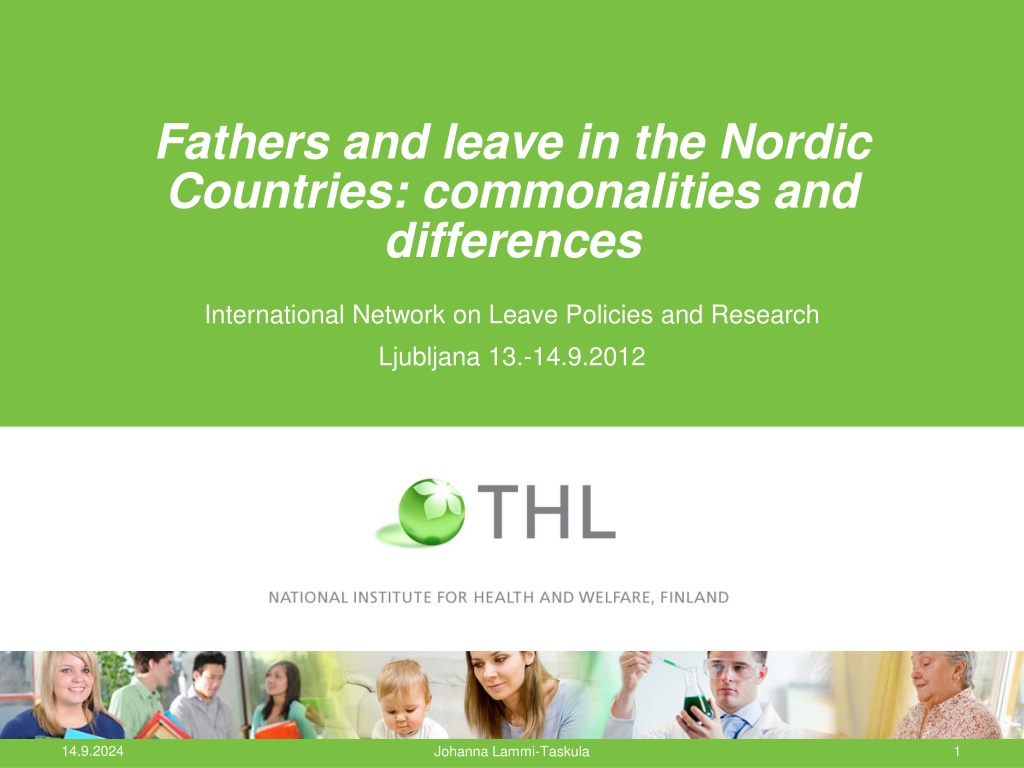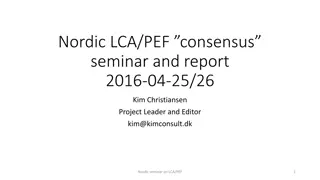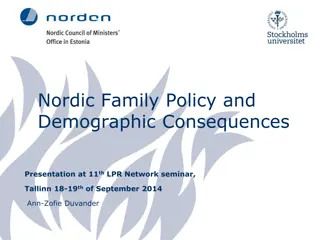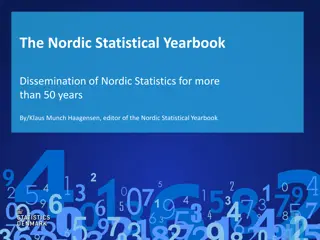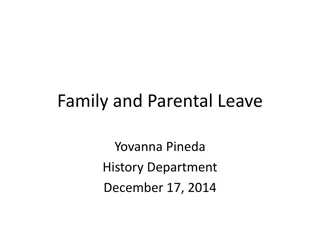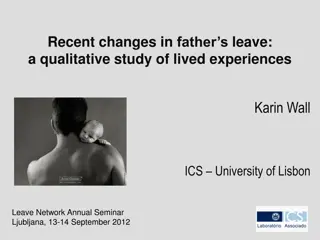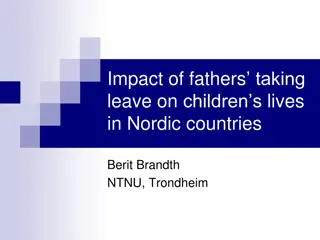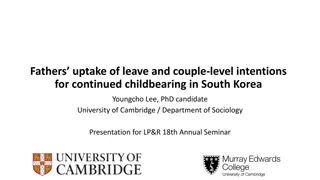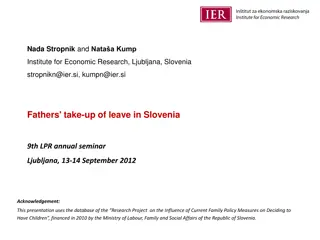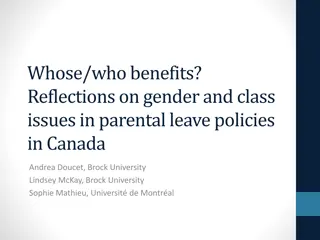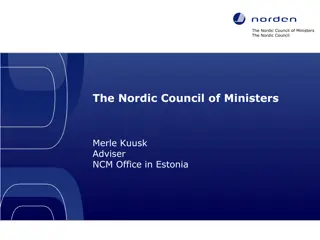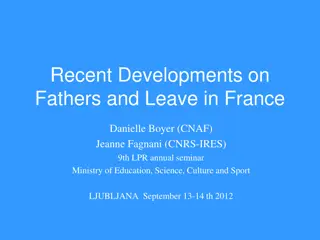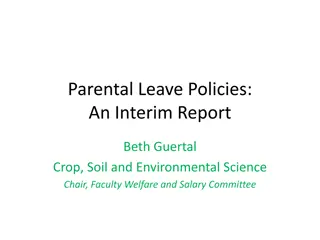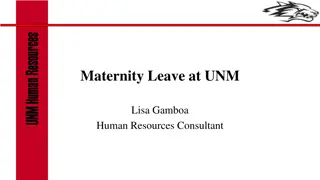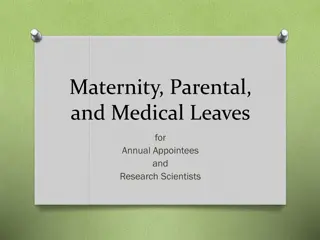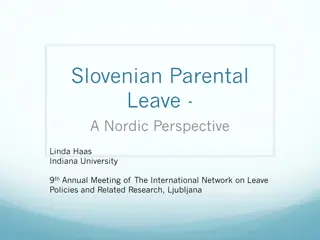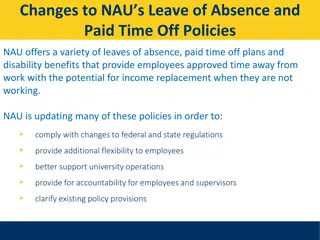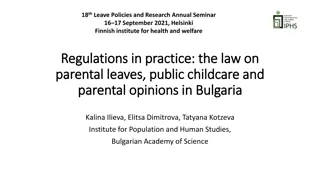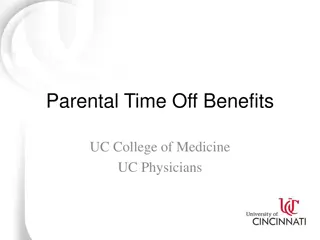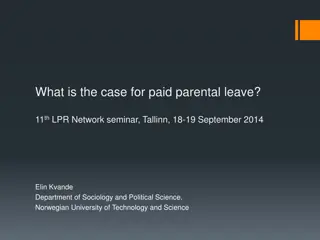Fathers and Parental Leave Policies in the Nordic Countries: Insights and Challenges
The Nordic countries have a long history of promoting parental leave and gender equality. Despite progressive policies, challenges remain in achieving equal parental leave uptake between mothers and fathers. This impacts women's position in the labor market and men's role in the family. The high fertility rates in these countries are partially attributed to supportive welfare systems and shared childcare responsibilities. Efforts to encourage fathers to take leave, such as father quotas, have been implemented, but more work is needed to achieve true gender balance in parental leave utilization.
Download Presentation

Please find below an Image/Link to download the presentation.
The content on the website is provided AS IS for your information and personal use only. It may not be sold, licensed, or shared on other websites without obtaining consent from the author. Download presentation by click this link. If you encounter any issues during the download, it is possible that the publisher has removed the file from their server.
E N D
Presentation Transcript
Fathers and leave in the Nordic Countries: commonalities and differences International Network on Leave Policies and Research Ljubljana 13.-14.9.2012 14.9.2024 Johanna Lammi-Taskula 1
Population (million) Sweden Denmark Finland Norway Iceland 9,3 5,5 5,4 4,8 0,3 Blue/green areas: More young people and women Yellow areas: More old people and men 14.9.2024 Johanna Lammi-Taskula 2
Total fertility rate 3.00 2.80 2.60 Denmark 2.40 Finland Iceland 2.20 Norway 2.00 Sweden 1.80 1.60 1970 1995 2009 Source: OECD Family Database 14/09/2024 3
Employment rate age group 20-44 Men Women 95 95 90 90 Denmark Finland Iceland Norway Sweden 85 85 80 80 75 75 70 70 2007 2008 2009 2010 2007 2008 2009 2010 Source: Eurostat 14/09/2024 4
Fathers and leave In the Nordic countries, the reconciliation of paid employment and family life has been supported by the welfare state since 1960 s. This may be one secret behind the high fertility rates. Fathers were first given leave rights in 1970 s. During the past two decades, father s quotas have been introduced to the leave schemes and campaigns designed to encourage more fathers to take leave. In principle, the leave legislation is based on an idea of shared childcare responsibility, as well as (almost) equal capability of both parents to take care of a child. In all countries, the employment rate of women is high and full-time employment is common. Still, the take-up of leave is not equally divided between mothers and fathers: mothers use majority of leave days. The unequal sharing of parental leave has negative consequences for women s position in the labour market as well as men s position in the family, especially in case of parental separation. 14.9.2024 Johanna Lammi-Taskula 5
History of parental leave schemes in the Nordic countries Maternity leave Paternity leave Parental leave Father s quota Denmark 1960 1984 Finland 1964 1978 Iceland 1946 1998 Norway 1956 1977 Sweden 1955 1980 1984 1985 1981 1978 1974 1997-2002* 2003 2001 1993 1995 *introduced again in the industrial sector in 2007 14.9.2024
Length of parental leave (income-related benefit) 80 70 60 50 weeks father both parents mother 40 30 20 10 0 Iceland Finland Denmark Norway Sweden
Length of paternity leave (taken after birth when the mother is at home) 3.5 3 2.5 weeks 2 1.5 1 0.5 0 Finland Denmark Norway Sweden Iceland
Length of childcare-related leave (income-related + flat-rate benefit) 40 35 30 25 flat-rate father parental mother months 20 15 10 5 0 Norway Finland Sweden Iceland Denmark
Level of benefits (2011) Denmark Finland Iceland Norway Sweden 100 %* 70-90 % 80 % 80-100 % 80 % maternity leave 100 %* 70 % - 0 %** 80 % paternity leave 100 %* 70-75 % 80 % 80-100 % 80 % parental leave 100 %* 70-75 % 80 % 80-100 % 80 % father's quota - 0 3307 NOK (407 ) 3000 SEK (344 ) 314 *** child care leave /flat-rate * with a ceiling (93 per day or 490 per week); full pay according to coll. agreements ** agreed in individual or collective agreements *** + means-tested supplement max 168 + 60-94 for siblings under school age
Fathers share of parental leave use Source: Nososco
Fathers use longer leave if 1st child High education of mother and father Middle/high income, but not above ceiling? Gender equality and/or child orientation? Public sector, female dominated work place Other fathers use leave at work Extra benefit from employer Individual leave rights (quota) + flexibility
Summary The Nordic countries have different leave models and can learn from each other s experiences. In all countries, mothers take more leave than fathers. There is a clear gender gap in employment rate especially in the age group 20-44. Iceland, Norway and Sweden have longer quotas for fathers and higher take-up of leave by men. Also in Finland the take-up has increased as the father s month has been made more flexible. In the quota-countries, fertility has increased more! 14/09/2024 Johanna Lammi-Taskula 13
